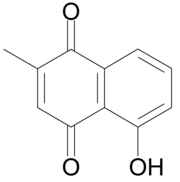Plumbagin
Appearance

| |

| |
| Names | |
|---|---|
| IUPAC name
5-hydroxy-2-methyl-naphthalene-1,4-dione
| |
| Identifiers | |
3D model (JSmol)
|
|
| ChEBI | |
| ChEMBL | |
| ChemSpider | |
| ECHA InfoCard | 100.006.882 |
| KEGG | |
PubChem CID
|
|
CompTox Dashboard (EPA)
|
|
| |
| |
| Properties | |
| C11H8O3 | |
| Molar mass | 188.17942 g/mol |
Except where otherwise noted, data are given for materials in their standard state (at 25 °C [77 °F], 100 kPa).
| |
Plumbagin or 5-hydroxy-2-methyl-1,4-naphthoquinone is an organic compound with the chemical formula C
11H
8O
3. It is regarded as a toxin[1] and it is genotoxic[2] and mutagenic.[3]
Plumbagin is a yellow dye,[1] formally derived from naphthoquinone.
It is named after the plant genus Plumbago, from which it was originally isolated.[4] It is also commonly found in the carnivorous plant genera Drosera and Nepenthes.[5][6] It is also a component of the black walnut drupe (Juglans nigra).
Pharmacologic properties
The following properties were described in various cellular and animal models:
- antimicrobial,[7][8]
- antimalarial,[9]
- anti-inflammatory,[10]
- anticarcinogenic,[11][12][13]
- cardiotonic,[14]
- immunosuppressive,[15]
- antifertility action,[16]
- neuroprotective,[17]
- anti-atherosclerosis effects.[18]
- Plumbagin has been shown to induce cell cycle arrest and apoptosis in numerous cancer cell lines including melanoma, lung, breast and others.[citation needed] It triggers autophagy via inhibition of the Akt/mTOR pathway and induces G2/M cell cycle arrest and apoptosis in A549 cells through JNK-dependent p53 Ser15 phosphorylation. Promotes autophagic cell death in MDA-MB-231 and MCF-7 cells and inhibits Akt/mTOR signaling. Induces intracellular ROS generation in a PI 5-kinase-dependent manner.
References
- ^ a b Black Walnut. Drugs.com.
- ^ "Genotoxicity of plumbagin and its effects on catechol and NQNO-induced DNA damage in mouse lymphoma cells". Jemal Demma, Karl Hallberg, Björn Hellman. 23 (2): 266–271. 2009. doi:10.1016/j.tiv.2008.12.007.
- ^ S B Farr, D O Natvig, and T Kogoma (1985). "Toxicity and mutagenicity of plumbagin and the induction of a possible new DNA repair pathway in Escherichia coli". J Bacteriol. 164 (3): 1309–1316. PMC 219331.
{{cite journal}}: CS1 maint: multiple names: authors list (link) - ^ van der Vijver, L. M. (1972). "Distribution of Plumbagin in the Plumbaginaceae". Phytochemistry. 11 (11): 3247–3248. doi:10.1016/S0031-9422(00)86380-3.
- ^ Wang, W.; Luo, X.; Li, H. (2010). "Terahertz and Infrared Spectra of Plumbagin, Juglone, and Menadione". Carnivorous Plant Newsletter. 39 (3): 82–88.
{{cite journal}}: CS1 maint: multiple names: authors list (link) - ^ Rischer, H.; Hamm, A.; Bringmann, G. (2002). "Nepenthes insignis Uses a C2-Portion of the Carbon Skeleton of L-Alanine Acquired via its Carnivorous Organs, to Build up the Allelochemical Plumbagin". Phytochemistry. 59 (6): 603–609. doi:10.1016/S0031-9422(02)00003-1.
{{cite journal}}: CS1 maint: multiple names: authors list (link) - ^ Didry, N.; Dubrevil, L.; Pinkas, M. (1994). "Activity of anthraquinonic and naphthoquinonic compounds on oral bacteria". Die Pharmazie. 49 (9): 681–683. PMID 7972313.
{{cite journal}}: CS1 maint: multiple names: authors list (link) - ^ de Paiva, S. R.; Figueiredo, M. R.; Aragão, T. V.; Kaplan, M. A. C. (2003). "Antimicrobial Activity in Vitro of Plumbagin Isolated from Plumbago Species" (pdf). Memórios do Instituto Oswaldo Cruz. 98 (7): 959–961. doi:10.1590/S0074-02762003000700017. PMID 14762525.
{{cite journal}}: CS1 maint: multiple names: authors list (link) - ^ Likhitwitayawuid, K.; Kaewamatawong, R.; Ruangrungsi, N.; Krungkrai, J. (1998). "Antimalarial Naphthoquinones from Nepenthes thorelii". Planta Medica. 64 (3): 237–241. PMID 9581522.
{{cite journal}}: CS1 maint: multiple names: authors list (link) - ^ Checker R.; Sharma D.; Sandur, S. K.; Subrahmanyam, G.; Krishnan, S.; Poduval, T. B.; Sainis, K. B. (2010). "Plumbagin inhibits proliferative and inflammatory responses of T cells independent of ROS generation but by modulating intracellular thiols" (pdf). Journal of Cellular Biochemistry. 110 (5): 1082–1093. PMC 3065107. PMID 20564204.
{{cite journal}}: CS1 maint: multiple names: authors list (link) - ^ Parimala, R.; Sachdanandam, P. (1993). "Effect of plumbagin on some glucose metabolizing enzymes studied in rats in experimental hepatoma". Molecular and Cellular Biochemistry. 125 (1): 59–63. doi:10.1007/BF00926835. PMID 8264573.
{{cite journal}}: CS1 maint: multiple names: authors list (link) - ^ Hsu, Y.-L.; Cho,, C.-Y.; Kuo, P.-L.; Huang, Y.-T.; Lin, C.-C. (2006). "Plumbagin (5-Hydroxy-2-methyl-1,4-naphthoquinone) Induces Apoptosis and Cell Cycle Arrest in A549 Cells through p53 Accumulation via c-Jun NH2-Terminal Kinase-Mediated Phosphorylation at Serine 15 in vitro and in vivo" (pdf). Journal of Pharmacology and Experimental Therapeutics. 318 (2): 484–494. doi:10.1124/jpet.105.098863. PMID 16632641.
{{cite journal}}: CS1 maint: multiple names: authors list (link) - ^ Attention: This template ({{cite doi}}) is deprecated. To cite the publication identified by doi: 10.1371/journal.pone.0018695 , please use {{cite journal}} (if it was published in a bona fide academic journal, otherwise {{cite report}} with
|doi= 10.1371/journal.pone.0018695instead. - ^ Itoigawa, M.; Takeya, K.; Furukawa, H. (1991). "Cardiotonic action of plumbagin on guinea-pig papillary muscle". Planta Medica. 57 (4): 317–319. doi:10.1055/s-2006-960106. PMID 1775570.
{{cite journal}}: CS1 maint: multiple names: authors list (link) - ^ McKallip, R. J.; Lombard, C.; Sun, J.; Ramakrishnan, R. (2010). "Plumbagin-induced apoptosis in lymphocytes is mediated through increased reactive oxygen species production, upregulation of Fas, and activation of the caspase cascade". Toxicology and Applied Pharmacology. 247 (1): 41–52. doi:10.1016/j.taap.2010.05.013. PMID 20576514.
{{cite journal}}: CS1 maint: multiple names: authors list (link) - ^ Bhargava, S. K. (1984). "Effects of plumbagin on reproductive function of male dog". Indian Journal of Experimental Biology. 22 (3): 153–156. PMID 6083981.
- ^ Son, T. G.; Camandola, S.; Arumugam, T. V.; Cutler, R. G.; Telljohann, R. S.; Mughal, M. R.; Moore, T. A.; Luo, W.; Yu, Q. S.; Johnson, D. A.; Johnson, J. A.; Greig, N. H.; Mattson, M. P. (2010). "Plumbagin, a novel Nrf2/ARE Activator, Protects against Cerebral Ischemia" (pdf). Journal of Neurochemistry. 112 (5): 1316–1326. PMC 2819586. PMID 20028456.
{{cite journal}}: CS1 maint: multiple names: authors list (link) - ^ Ding, Y.; Chen, Z.-J.; Liu, S.; Che, D.; Vetter, M.; Chang, C.-H. (2005). "Inhibition of Nox-4 activity by plumbagin, a plant-derived bioactive naphthoquinone". Journal of Pharmacy and Pharmacology. 57 (1): 111–116. doi:10.1211/0022357055119. PMID 15638999.
{{cite journal}}: CS1 maint: multiple names: authors list (link)
